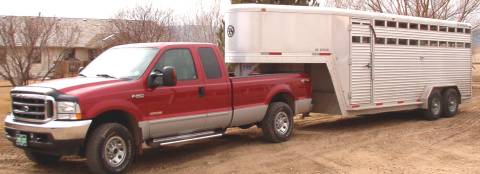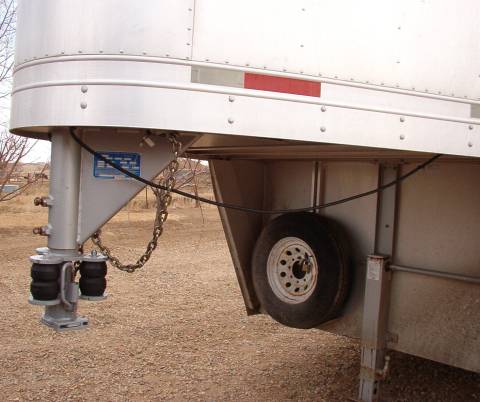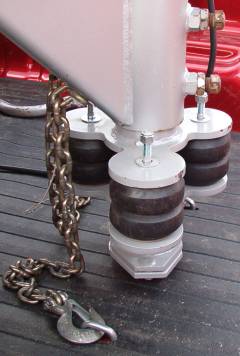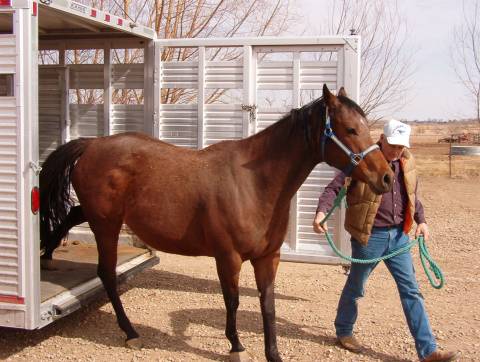|
"Popup
CC1 & CC2 Cushion Coupler"
for a Heavy Duty Softer Ride with a built in ball
guide.
 New Popup coupler on the Cushion Glide Coupler,
allows you to hook and unhook your trailer without climbing in the
bed. Just pull the remote cable to allow the coupler to slide over
the ball or to release the ball. It's spring loaded, tapered to the
socket, for easy ball alignment and even has a grease zerk. says MrTruck.
Click picture to enlarge.
New Popup coupler on the Cushion Glide Coupler,
allows you to hook and unhook your trailer without climbing in the
bed. Just pull the remote cable to allow the coupler to slide over
the ball or to release the ball. It's spring loaded, tapered to the
socket, for easy ball alignment and even has a grease zerk. says MrTruck.
Click picture to enlarge.
Read about the new improved
Popup Cushion Coupler |
Original review, new model available now. When
I review a new product, I like to use it on other folks trucks and
trailers. Not that I wouldn't mind keeping all this cool stuff, but I
want more opinions from the real world. Kenny Brown volunteered to help
me evaluate this new Cushion Glide Coupler on his 20' aluminum stock
trailer. Installation of the new cushion coupler was a snap, just loosen
the two adjustable coupler tube wedge bolts and the old coupler falls
out, watch your toes. Slide the Cushion Glide Coupler up the neck tube
and retighten the two wedge (set) bolts and you are ready to go. I did
measure first were the old coupler was, so I have a place to start
adjusting the new cushion coupler. We used model CC1 with a 4000# tongue weight
rating.
|

|
|
 Kenny Brown's rig, a 03 Ford
F250 8' bed, diesel with factory "camper package", B&W ball hitch and
20' box Exiss aluminum stock trailer. The unit was setup relatively
level. We setup the Cushion Glide Coupler down about an inch more than
the standard hitch, raising the front of the trailer, to be level when
loaded with 2 to 3 horses as Kenny's most common load and not be too
high in the front when empty, so as not to affect the trailer brakes. Kenny Brown's rig, a 03 Ford
F250 8' bed, diesel with factory "camper package", B&W ball hitch and
20' box Exiss aluminum stock trailer. The unit was setup relatively
level. We setup the Cushion Glide Coupler down about an inch more than
the standard hitch, raising the front of the trailer, to be level when
loaded with 2 to 3 horses as Kenny's most common load and not be too
high in the front when empty, so as not to affect the trailer brakes. |
 The
one thing I was concerned about, is with the larger head on the coupler,
would there still be enough room to lower the front of the trailer with
the adjustable neck? I could see that raising the trailer would be no
problem. We drove the trailer with a couple of horses (2500#'s) loaded
in the front compartment, to give us an idea of where to adjust the
coupler for a heavy load. When I had the coupler adjusted to be level on
the loaded trailer, we still had 2 inches of adjustment left between the
coupler top Timbren rubber spring bracket and the gooseneck tube. And
two inches is a lot, so I was satisfied that Rehme Mfg. did their
homework measuring goosenecks and trucks. More.... The
one thing I was concerned about, is with the larger head on the coupler,
would there still be enough room to lower the front of the trailer with
the adjustable neck? I could see that raising the trailer would be no
problem. We drove the trailer with a couple of horses (2500#'s) loaded
in the front compartment, to give us an idea of where to adjust the
coupler for a heavy load. When I had the coupler adjusted to be level on
the loaded trailer, we still had 2 inches of adjustment left between the
coupler top Timbren rubber spring bracket and the gooseneck tube. And
two inches is a lot, so I was satisfied that Rehme Mfg. did their
homework measuring goosenecks and trucks. More....
With a standard gooseneck coupler, you have a fairly solid connection
between the truck and trailer. The Cushion Coupler will cushion the impact between truck and trailer. Inside the coupler
is a solid steel square shaft that slides in a rubber type sleeve
similar to a torsion axle. This part of the coupler also absorbs shock
as does a torsion axle, with three Timbren rubber springs doing
most of the work. Timbren rubber springs are a popular aftermarket truck
overload. Many truck manufactures use rubber springs to cushion their
suspensions. The Timbren rubber cushions have a
lifetime warranty.
Order the CC1
$623 & CC2 $691 |
 Hitch
shows how much room we had left for adjustment, if we needed to drop the
front of the trailer. The Timbren rubber spring guide bolts come up when
your loaded. We were properly adjusted here, turning the coupler
clockwise for the bolts to have clearance with the safety chains and
neck gusset brace. Hitch
shows how much room we had left for adjustment, if we needed to drop the
front of the trailer. The Timbren rubber spring guide bolts come up when
your loaded. We were properly adjusted here, turning the coupler
clockwise for the bolts to have clearance with the safety chains and
neck gusset brace. |
 Here
we didn't have the coupler adjusted and were too close to the safety
chain with the rubber spring guide bolt. It was approximately 60 degrees
F and we had 2 1/4" of the guide bolt sticking up with the loaded
trailer. With the empty trailer, the guide bolt only stuck out 3/8".
We'll review this again this summer at 90 degrees F and see if the
softer rubber improves on the already good ride. But I'll ride inside
with the AC on and take pictures out the rear window.
S
More.... Here
we didn't have the coupler adjusted and were too close to the safety
chain with the rubber spring guide bolt. It was approximately 60 degrees
F and we had 2 1/4" of the guide bolt sticking up with the loaded
trailer. With the empty trailer, the guide bolt only stuck out 3/8".
We'll review this again this summer at 90 degrees F and see if the
softer rubber improves on the already good ride. But I'll ride inside
with the AC on and take pictures out the rear window.
S
More.... |
Kenny and I both drove the truck and trailer
with the old coupler, the new coupler empty and loaded with 2 horses
(approximately 2500#'s) in the front compartment and then split up with the
heaviest, 16 hand Quarter Horse in the rear compartment. I didn't see a big
difference with the empty trailer before and after we added the Cushion Coupler. We crossed a railroad track and could see some movement in
the Timbren rubber springs. Loaded you could feel a difference in an
improved ride with Cushion Coupler. We drove on pavement and dirt
roads.
Order the CC1
$623 & CC2 $691
 The
standard coupler. The
standard coupler. |
 The
new hitch, Cushion Glide Coupler The
new hitch, Cushion Glide Coupler |
The biggest difference I could see was in
slowing down, speeding up, starting and stopping. The Cushion Coupler
took the shock out of the movement. Have an improved ride is nice but
reducing the jerk between the truck and trailer impressed me. I drive in
heavy traffic in Denver and try as you might to allow room between you and
other drivers and the gap just keeps filling in with those little cars. So
when your truck pitches forward in a panic stop, this coupler can help
cushion the jolt and rebound from the sudden stop.
|
 |
 It even matches the color of your gooseneck
and your spare tire! The bottom of the Cushion Coupler is tapered
inward ball guide to allow easier ball hookup, even if you aren't perfect at backing up
your trailer. Now of course the ultimate test was Kenny Browns wife,
Sandy. She drove the truck and trailer at the end of our grueling test
drives while Kenny and I rested in the barn near the refrigerator. And
Sandy's quote was "the hitch makes the truck and trailer ride better." What
else can I say except that Kenny just got back from a 2000 mile trip from
Ft. Collins Colorado to Farmington and Clovis New Mexico and back, hauling a
couple of mares (approximately 2400#'s) using the CGC. This long term test
was successful, Kenny noticed less horse motion from the trailer verses
other similar trips. He also stated that his F250 felt more like the
stability you notice with a dually. It even matches the color of your gooseneck
and your spare tire! The bottom of the Cushion Coupler is tapered
inward ball guide to allow easier ball hookup, even if you aren't perfect at backing up
your trailer. Now of course the ultimate test was Kenny Browns wife,
Sandy. She drove the truck and trailer at the end of our grueling test
drives while Kenny and I rested in the barn near the refrigerator. And
Sandy's quote was "the hitch makes the truck and trailer ride better." What
else can I say except that Kenny just got back from a 2000 mile trip from
Ft. Collins Colorado to Farmington and Clovis New Mexico and back, hauling a
couple of mares (approximately 2400#'s) using the CGC. This long term test
was successful, Kenny noticed less horse motion from the trailer verses
other similar trips. He also stated that his F250 felt more like the
stability you notice with a dually.
For less stressful trailering, the CC1 is
dramatically less expensive than an air ride hitch,
no maintenance, it's automatic and easy to install. Proven to be a strong
heavy duty coupler, the tests of the Cushion Coupler at U-Haul Tech
center in Tempe, AZ for its ability to support the proposed SAE test loads without
breaking or separating from the hitchball, passed all the different trailer
load directional force tests dramatically beyond what you could do to the
hitch in the real world.
|

|
|
Happy horse, fun ride,
less fatigue on everyone. If you are ordering a new trailer, tell them
you want the Cushion Coupler in lieu of the standard coupler. It's
an option on most horse trailers. |
Most folks
have their trailers loaded most of the time, but if you do pull an empty
trailer often, you can add a spacer under one of the three Timbren Rubber
Cushions. Using a "1/4” to "3/8" washer under one cushion, would soften the
ride when pulling empty or with a light load. As the load increases it kicks
in the other 2 cushions. The rubber cushion will still compress over the
spacer washer when loaded, but will soften the empty trailer ride. Ask for
the spacer washer when you order. Set the coupler at the proper height
loaded and leave it alone, it will ride a little higher empty but not
enough to matter, you have to take in account that the trailer when empty is
also running a little higher- it equals out.
If your
truck has air suspension, which helps the ride, you still have a fairly
solid connection between the truck and trailer. The Cushion Coupler
will still cushion the impact between truck and trailer, inside the coupler,
is a solid steel square shaft that slides in a rubber type sleeve similar to
a torsion axle. This part of the coupler also absorbs shock, as does a
torsion axle
The CC1 was designed
as a direct replacement for you're current coupler. It is about 1/2" taller
unloaded than the current Stallion or Hammerblow models but it shortens up
loaded so it will have to be set a little lower than a solid coupler, so a
person with a tall truck can level out the trailer which they couldn't do
before. The CC in its current configuration should fit all trucks coming
out of the factory today.
|
Two models for
two tongue weight ratings. |
|
CC1 |
Cushion Glide Coupler |
(600 - 4,000 lb) |
|
CC2 |
Cushion Glide Coupler |
(4,000 - 8,000 lb) |
Also for the best deals on
Timbren truck springs visit
www.cushionglide.com
Order the CC1
$623 & CC2 $691
HOME PAGE
1) (2)
(3)
(4) |









 It even matches the color of your gooseneck
and your spare tire! The bottom of the Cushion Coupler is tapered
inward ball guide to allow easier ball hookup, even if you aren't perfect at backing up
your trailer. Now of course the ultimate test was Kenny Browns wife,
Sandy. She drove the truck and trailer at the end of our grueling test
drives while Kenny and I rested in the barn near the refrigerator. And
Sandy's quote was "the hitch makes the truck and trailer ride better." What
else can I say except that Kenny just got back from a 2000 mile trip from
Ft. Collins Colorado to Farmington and Clovis New Mexico and back, hauling a
couple of mares (approximately 2400#'s) using the CGC. This long term test
was successful, Kenny noticed less horse motion from the trailer verses
other similar trips. He also stated that his F250 felt more like the
stability you notice with a dually.
It even matches the color of your gooseneck
and your spare tire! The bottom of the Cushion Coupler is tapered
inward ball guide to allow easier ball hookup, even if you aren't perfect at backing up
your trailer. Now of course the ultimate test was Kenny Browns wife,
Sandy. She drove the truck and trailer at the end of our grueling test
drives while Kenny and I rested in the barn near the refrigerator. And
Sandy's quote was "the hitch makes the truck and trailer ride better." What
else can I say except that Kenny just got back from a 2000 mile trip from
Ft. Collins Colorado to Farmington and Clovis New Mexico and back, hauling a
couple of mares (approximately 2400#'s) using the CGC. This long term test
was successful, Kenny noticed less horse motion from the trailer verses
other similar trips. He also stated that his F250 felt more like the
stability you notice with a dually. 